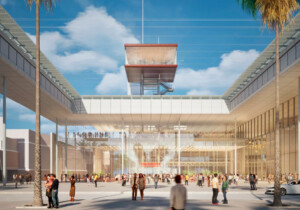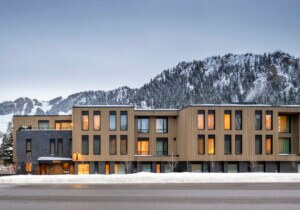Driving through Miami Beach on Florida’s A1A highway, one cannot help but notice the particular brand of American beach culture passing by—an eclectic architectural mix of decades-old spring break destinations, vintage art deco buildings, and glossy new condo developments. A one-mile stretch of Miami Beach, for example, contains 14 mid-century structures including five of Morris Lapidus’s flamboyant resorts, while the blocks between 32nd and 36th streets are home to a burgeoning $1 billion arts, cultural, and residential development involving Foster + Partners, OMA, and Philippe Starck.
If you manage to escape this commotion and continue north, you will hit Fort Lauderdale. Here—just 23 miles up the road, but in a comparatively calmer setting—is one of Michael Graves’s last built works: a nautically inspired, ocean liner-like structure known today as the Ocean Resort Residences. The project was initially developed as the Trump International Hotel & Tower Fort Lauderdale, but development halted during the 2008 financial crisis. The building fell under foreclosure about six months from its scheduled opening. Graves’s office pulled out of the project and the building sat vacant for four years until CFLB Group purchased it with plans to develop it into a Conrad, Hilton’s luxury brand.
Many groups have had a hand in the shaping and repositioning of this building, overlaying their own political agendas and recasting narratives that freshen up the experience for today’s evolving luxury market. Prior to reselling the property, the bank repainted Graves’ contextual pastel sky blue and sandy beach tan scheme a stark modern white, presumably to make the building more marketable to luxury condo buyers. After acquiring the building, Conrad spent the next two years completely reimagining Graves’ interiors. The project is now in its third interior design scheme and is finally nearing completion. Conrad’s revamped interiors pair Graves’ nautical inspiration for the exterior with thematic yacht-like detailing through custom material selections and furnishings like teak wood paneling, leather trim, and furnishings such as modified marine table lifts re-contextualized into dining room tables.
Today, as the Ocean Resort Residences are set to open to the public, we are reminded of Graves’s associations with Le Corbusier and the New York Five. Whether intentional or not, the Ocean has brought Michael Graves’s career full circle. We owe this to the unlikeliest of sources: the foreclosure bank that left its mark on the building by painting it white.
Michael Graves’s career began with his participation in the New York Five, a group of architects nicknamed “The Whites” by the press primarily because their work resembled more neutral white abstract forms. The projects of the Whites were a series of built houses which borrowed largely from early Corbusian-inspired form. Despite the nickname, the Whites held a very strong interest in the use of color in the work of Michael Graves and John Hejduk. In fact, Graves had claimed in interviews that his early houses were intended to be colored but that his clients rejected such schemes in favor of all white exteriors. Graves’s career evolved beyond the New York Five era, adopting an architectural language aligned with a commercial populism: design for the masses centered around colorful and legible, yet abstracted, classical forms.
The story here is ultimately not about Graves’ contribution to the architectural scene along the A1A, nor the fact that this building is one of the last that he ever designed. Rather, it is about a disciplinary question of legacy, authorship, and narrative. Would it be correct to call the 2015 posthumous Conrad version of this building a Michael Graves project, or should we avert our eyes, referring instead only to sketches and a few marketing photos of the incomplete Trump version which no longer exists?
Graves’s contribution here is not a tangible building, but rather a narrative about contextualism. In the end, what we are left with is a sail-like gridded white facade, and a thematized luxurious interior loaded with a fresh new amenities package that perhaps even Le Corbusier would enjoy.










